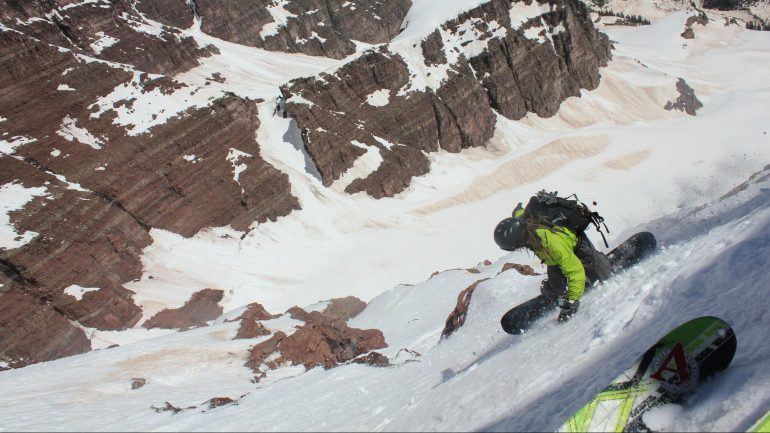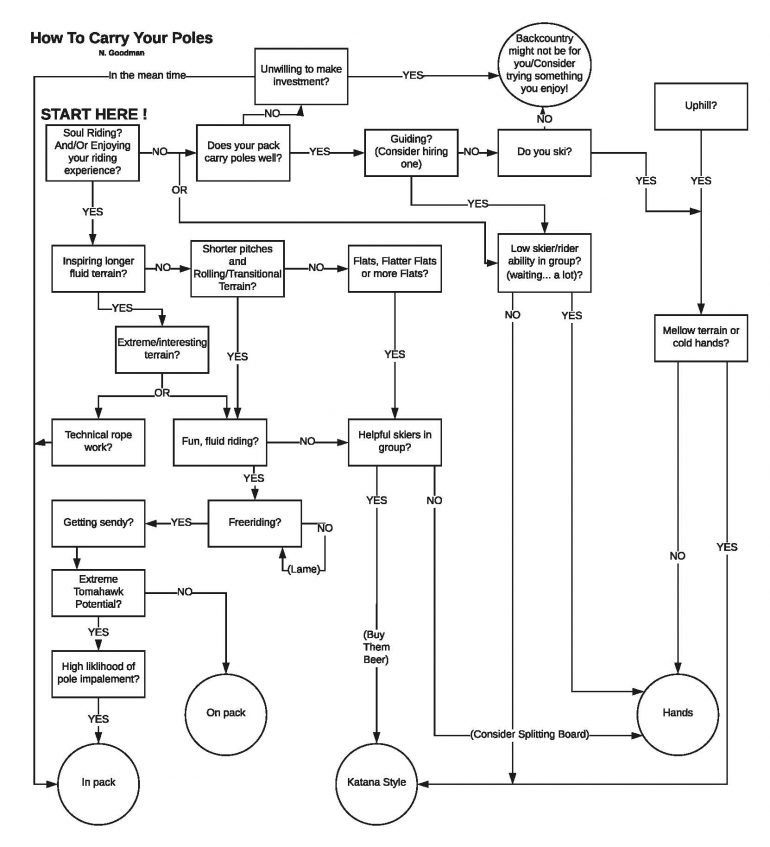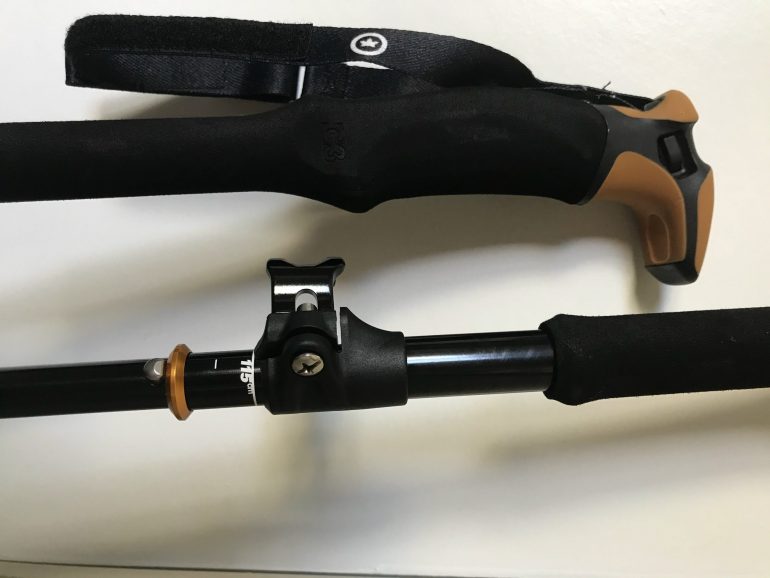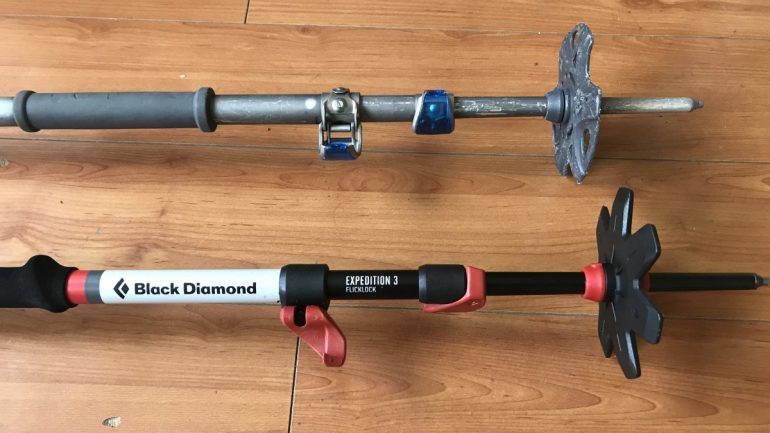Dissection and review of two common poles
The splitboard pole could be the most overlooked companion to any backcountry kit. Aside from the actual splitboard and immediate accouterments, the “Splitboard Pole” is arguably the least adaptable tool that needs specific design elements to enhance its usability. Features can make or break a pole (pun intended). While the majority of poles are good enough – with talent (or grit) any product will do – certain features actually make touring easier.
What follows is a review of two splitboarding poles – the G3 Pivot Pole, and the Black Diamond Expedition 3 – and analysis of what makes them exceptional. This piece asks the following questions: Which features allow for splitboard-specific efficiency and function? And, how can pole choice be adapted objectively?
When selecting a pole, I ask: “What does snowboarding in the mountains look like to me?” My response is fluid and changes daily. It is tailored to my region of exploration, the partners with whom I ride, my general views as a rider, and my chosen objective.
I splitboard seeking a higher quality of riding experience. On any given descent, where my poles go while riding influence my experience. In summary: Poles on/in the pack = freedom and soul expression at the expense of efficiency. VS. Poles in hand = gained efficiency and happier [ski] partners at the loss of expressive freedom and precision.
For the nerds (push the glasses back on the nose and focus), a dissection of stats may be useful: pole weight, materiality and construction, collapse mechanics and the dependability of the lock mechanism, and finally pole storage – how it fits on/in/against the pack, or is hand-held.
POL – OL – O – GY: the speciation of the Splitboard Pole
Four species of poles exist in our world and can be placed in two categories: ones that work [well for splitboarding] and ones that don’t. Following this model, the modern splitboarder utilizes a four–piece “foldable/compacting” pole, exemplified in the G3 Pivot, or a three piece “collapsible/extendable” pole like Black Diamond’s Expedition 3. To achieve a certain amount of grace and mountain flow, we throw out the standard “solid/fixed length” ski pole, and the two piece “adjustable” pole. They are too bulky and lacking in versatility for our needs as splitboarders.
The three-piece “collapsible/extendable” pole has existed in many different forms. Black Diamond’s “Expedition 3” and their foldable “Compactor” are go-tos for many riders and in some ways have shaped industry standard. Following are some field observations of the new packable G3 Pivot in comparison with a three-section BD Expedition.
G3 Pivot Pole
New for 2020, the G3 Pivot Pole is an exceptional iteration of the four piece “packable” pole. I recently took this pole on two hut trips: Sorcerer Lodge and Ymir Lodge. The poles lived outside enduring consistent cold temperatures (-20 – -10 C) for a total of 12 days – up to 7 days in sequence -unthawed. They remained packable, shedding ice and maintaining structural integrity, while withstanding a variety of tests.
Consider a serious “pole-intensive” situation like the following: a butt clenching, forgetting-to-breathe kick turn on wind hardened alpine snow. You’ve already resorted to death gripping your poles and are hoping you can hang on a second longer — before the friction between your peeling skin and the snow (lost that tail clip huh?) or your chipped-in-edge (should have put my heel riser down!) fail — while you cat claw your planks back to parallel. You increasingly weight your poles instead of your boards and they flex, arc, then bend seemingly to the point of no return…
The G3 Pivot remains uncompromisingly rigid in the above situation and withstands my meat flopping (body weight) repeatedly. Other folding models bend to a “doubt-catalyzing” degree. The Pivot preserves its ability to fold in humid British Columbian environments, and demonstrated a high degree of resistance to snapping [shear strength]. This was tested excessively while hacking kickturn corners and traverse tracks into a pronounced (20cm thick) impenetrable rain crust (knife to ice density) kilometer by kilometer, for days on end.
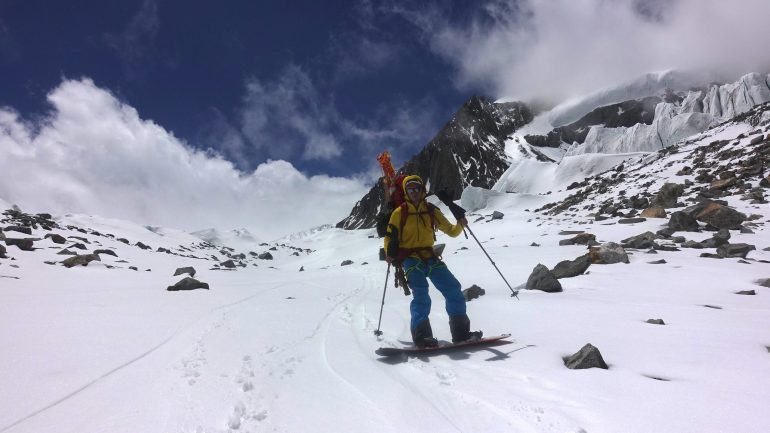
Poles in Hand proving useful while crossing flat variable terrain with an enormous pack and alternative snowboard methods. Zhongshan Feng, China. Photo: Liu Jin Fu
This pole shines brightly in the “packable/foldable” variety for a number of reasons:
Packability and Draw: Once packed, the pole demonstrates a secure self-binding mechanism. The cable connecting the pole pieces wraps over the top of the pole, allowing for a bomb-proof interface between the powder basket and a single pole-piece. The G3 Pivot Pole remains unified inside the pack or out. Other brand’s interpretations are not self binding and depend on the powder basket alone as a uniting mechanism. The Pivot also has prominent rings that allow for the quick deployment into touring mode. The clamp lock provides an easy, secure mechanism for length adjustment.
Engineering and Design: The pole has been engineered to meet and exceed the unique needs and expectations of splitboarders. It manipulates bindings precisely. Different than other poles, the G3 Pivot features a lower-profile angulated molding of the pommel and a thoughtfully designed utility nose, which increases agility and precision while pushing and pulling on levers, bars, and the like. These work with Spark’s Whammy Bars, the classic Voile Dual Height Climbing Heels, or any other heel riser for hard or soft boot systems. It also works exceptionally well for tech toe pieces.
The Pommel: The molded handle fits the hand well and the thumb catch allows for an easy grip while touring in mild terrain. The foam on the shaft and rib rings allow for “chokeability” on the pole shaft while side hilling.
Pole Strength: The G3 Pivot Pole features high-grade aluminum and performs as a rigid pole while preserving the benefits of a foldable, packable pole.
Bonus Features: The pommel offers clip points allowing the poles to double as tent anchors. The wrist straps are easily removable.
That said – the pole has some distinct weaknesses:
The Single Suppression Point: (common in all packable poles) innately creates a weakness in the pole (think perforation). In light of honest review I broke one of them after 15 days of constantly hacking through ice crust. I deem this an extenuating circumstance as this act would push the limit of any pole.
Although not observed, in the field I have a hard time believing in this mechanism as being un-freezable and infallible (based on experiences with other poles of this type). Had conditions been colder or wetter, the chances of freezing up are high.
The Handle Shape: is more pronounced and less symmetrical than some other models. This makes it more difficult to plunge into harder snow to conduct rough column tests, etc. The foam on the grip is prone to snow and moisture collection. This is accentuated in cold, humid environments.
If the Pole Breaks: its construction dictates the necessity for a replacement. Modular parts are not currently an option for this pole, or any compacting/foldable type pole.
More thoughts than truths: The pole packs up very small and securely. Although excellent inside the backpack, “two strap security” may be difficult to achieve on the outside of the pack. When pole access is paramount and I want the use of my hands, I utilize a Katana-Style – stuffing the poles under a shoulder strap and against my back. There are obvious health risks associated with storing hard objects against one’s spinal column, ribs, scapula, etc, and I assume these for the sake of efficiency. The packed poles are so small when folded that they don’t quite wedge into my backpack/bone sheath. Alternatively the pole is just long enough when extended that it inhibits motion when stored similarly. Additionally, the pole length doesn’t shorten to a small threshold length, which can lead to an awkward size while boot packing (cry me a river – skiers deal with long poles all the time).
Black Diamond Expedition 3
This three-piece collapsible pole features two FlicLock points to maximize strength and collapsibility/extendibility. It is the industry standard for this specie of pole and is widely used by practitioners and outfitters of all types because of its dependability, usability, and its modular nature. Many generations of the Expedition 3 have come to pass — a testament to their robustness. The current generation is the most resilient iteration yet.
This pole has confidently accompanied me into mountain ranges all over the Lower 48, Alaska, Canada, four winters in Japan, and on multiple expeditions in China. As the namesake dictates, the pole is engineered for expedition travel. Collapsible and superior in strength, it remains rigid in stressful situations and has proven to be extremely durable. Black Diamond boasts one of the largest adjustable ranges on the market (65-140cm) and its versatility allows for high functionality in a variety of environments and mountaineering situations.
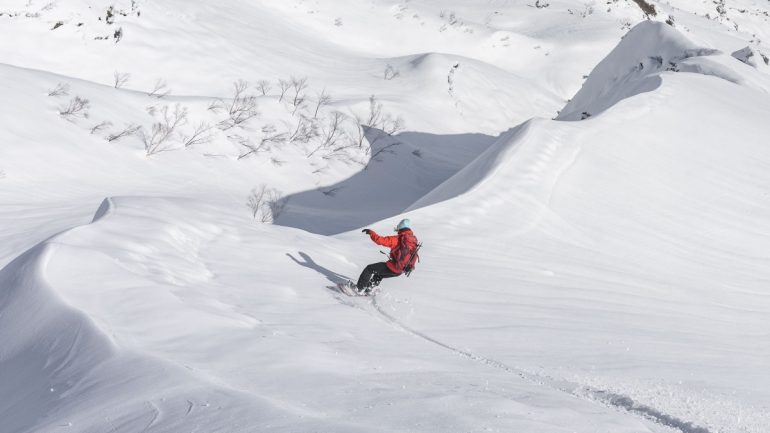
Lay’n back and slashing on a slushy day, Putting the poles on the pack opens the soul to all of the freedom the terrain offers. Hakuba Backcountry, Japan. Photo: Rolland Miller
Collapsibility and Draw: The pole can achieve functional lengths of 85–140cm making it highly adaptable for different climbing modalities – particularly advantageous while boot packing and pushing on the flats. Poles break and when they do, having the ability to swap out a broken section for a freshie is handy, especially when on an expedition or away from civilization for a longer period of time.
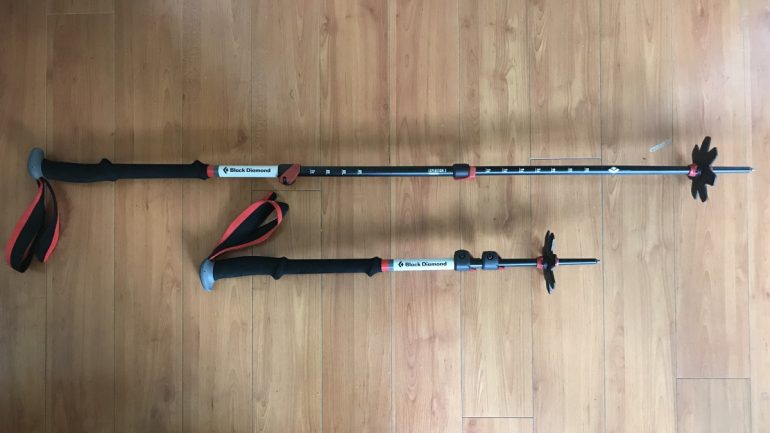
The Expedition 3 is highly packable and offers the bonus feature of being able to individually replace segments.
Pole Strength and Design: The current iteration features a “powder coated” aluminum, which repels ice and moisture (an improvement over the last generation), and a plastic FlicLock –- Black Diamond’s developed pole clamping mechanism. The Flicklock is screw adjustable allowing for increased compression. Depending on your situation this can increase your security or efficiency. Previous generations utilized the FlicLock Pro – a less wear-tolerant, less adjustable, and more snagable variety of the lock mechanism. Each section is made from a different gage of aluminum, allowing for a robust telescoping feature.
The Pommel and Handle: The Expedition 3 provides an exceptionally comfortable ergonomic handle and a long foam grip extending down the upper half of the pole. With ample room between the foam and first FlicLock, the shaft is extremely tape-able to allow for improved grip while side hilling. The pommel is rounded and fits nicely into the palm while pushing. The handle is equipped with an extended nose geared toward the manipulation of bindings.
Long term experience with this pole has exposed design flaws and weaknesses:
The Pommel is substantially rounded making it difficult to push on wires (particularly the Whammy Bar). The lip isn’t pronounced, making it difficult to manipulate risers. Additionally, the foam covered haft is prone to moisture collection and ice build up. This is accentuated in cold, humid environments. This is a huge bummer because in previous generations, the haft was coated in ribbed rubber.
The FlicLock is made of plastic. By nature of material this is weaker than metal. Additionally, the shape of the mechanism allows for snow packing.
The Aluminum Gage decreases as the pole sections near the ground. This means the most shear stress is placed on weaker sections of the pole. My experience shows the mechanical advantage exerted on the weaker materials in the middle-pole section break it with some frequency.
The Final Pole Section is tapered near the powder basket. This allows for approximately 25cm of movement before the FlicLock physically clamps against something. The situation allows for the potential opening of the lock mechanism, and loss of a pole section. (Embarrassingly to me, this happens).
Two FlickLocks and three pole sections introduce more failure points into the system. Managing the system requires attention and awareness.
My bottom line: As a snowboarder, finding the right poles and the best ways to use them requires less habit, more pattern recognition, and exceptional awareness of self, environment, and partners.
I’m fortunate to have the G3 Pivot and Black Diamond Expedition 3 in my quiver. When I seek the soul experience, day tour with friends, or ride serious terrain, I’m likely to use the Pivot for its packability, and durability. When I’m less certain of what a trip holds due to length, environment, or conditions, I’ll probably utilize the BD collapsible variety.
Shop for the Black Diamond Expedition 3.
Shop for the G3 Pivot.
Nate Goodman currently lives in Whistler BC. He is a full time multidisciplinary guide, living a transitional life between North America, Japan and China. Nate is a disciple of core snowboarding, curious about the arcane nature of mountains, and is committed to the pursuit of enlightenment through the consumption of Sichuan-Chinese Food.
Nate Goodman currently lives in Whistler BC. He is a full time multidisciplinary guide, living a transitional life between North America, Japan and China. Nate is a disciple of core snowboarding, curious about the arcane nature of mountains, and is committed to the pursuit of enlightenment through the consumption of Sichuan-Chinese Food.

